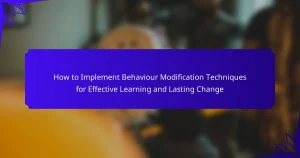Psychological conditioning approaches enhance learning, modify behavior, and build emotional resilience. This article explores classical conditioning, operant conditioning, and cognitive-behavioral techniques. It discusses their application in education and their role in fostering adaptive behaviors. Additionally, it examines how these methods improve emotional regulation and overall well-being.

What are the psychological conditioning approaches enhancing learning today?
Psychological conditioning approaches such as classical conditioning, operant conditioning, and cognitive-behavioral techniques enhance learning by modifying behavior and fostering emotional resilience. Classical conditioning builds associations between stimuli, while operant conditioning utilizes reinforcement and punishment to shape behavior. Cognitive-behavioral techniques focus on changing thought patterns to improve emotional responses and learning outcomes. These methods are increasingly integrated into educational practices, promoting a deeper understanding of student behavior and emotional health.
How does classical conditioning influence modern educational practices?
Classical conditioning significantly shapes modern educational practices by enhancing student engagement and behaviour management. Educators utilize conditioned responses to create positive learning environments. For example, consistent rewards for participation reinforce desired behaviours, improving overall classroom dynamics. This approach also fosters emotional resilience by associating learning with positive experiences, leading to increased motivation and retention. Research indicates that classrooms employing classical conditioning techniques see higher student achievement and satisfaction.
What role does operant conditioning play in behaviour modification?
Operant conditioning significantly influences behaviour modification by reinforcing desired behaviours through rewards and discouraging undesired ones with consequences. This approach enhances learning by establishing clear connections between actions and outcomes. For instance, positive reinforcement, such as praise or rewards, increases the likelihood of a behaviour being repeated. Conversely, negative reinforcement or punishment can decrease unwanted behaviours. The effectiveness of operant conditioning is evident in various settings, including education and therapy, where structured reinforcement strategies lead to improved emotional resilience and behavioural changes.
What are the key principles of operant conditioning?
Operant conditioning is based on four key principles: reinforcement, punishment, extinction, and shaping. Reinforcement increases desired behaviours, while punishment decreases undesired behaviours. Extinction occurs when reinforcement is removed, leading to a decline in behaviour. Shaping involves reinforcing successive approximations of a target behaviour, facilitating gradual learning.
How can reinforcement schedules be applied effectively?
Reinforcement schedules can be applied effectively by tailoring them to individual learning needs. For instance, using variable ratio schedules can enhance engagement by providing unpredictable rewards, thus increasing motivation. Consistency in reinforcement timing is crucial; immediate reinforcement strengthens behaviour more than delayed responses. Gradually transitioning from continuous to intermittent reinforcement helps maintain behaviour over time. Monitoring progress and adjusting schedules based on performance ensures optimal effectiveness.
What unique psychological techniques are emerging in learning environments?
Emerging psychological techniques in learning environments focus on personalised conditioning strategies that enhance engagement and retention. Techniques like gamification apply behavioural reinforcement to motivate students, while mindfulness practices build emotional resilience, reducing stress and improving focus. Adaptive learning technologies leverage data to tailor experiences, ensuring optimal challenge levels. Collaborative learning environments foster social conditioning, enhancing peer interactions and group dynamics. These approaches collectively aim to create more effective and supportive educational experiences.
How is cognitive-behavioral therapy integrated into educational settings?
Cognitive-behavioral therapy (CBT) is integrated into educational settings to improve student behaviour and emotional resilience. It equips educators with strategies to address mental health issues and enhance learning outcomes. CBT techniques, such as cognitive restructuring and behaviour modification, help students develop coping mechanisms and foster a supportive learning environment. Research shows that implementing CBT in schools can lead to a significant reduction in anxiety and behavioural problems. This integration promotes overall well-being and academic success among students.
What innovative technologies support conditioning methods?
Innovative technologies supporting conditioning methods include virtual reality, artificial intelligence, and mobile applications. These tools enhance engagement, provide personalised feedback, and facilitate real-time monitoring of behaviour changes. Virtual reality immerses users in controlled environments, allowing for safe exposure to stimuli. Artificial intelligence analyses user data to tailor conditioning programmes, improving efficacy. Mobile applications offer accessible platforms for practice and reinforcement, fostering emotional resilience through consistent engagement.
What rare attributes define successful emotional resilience through conditioning?
Successful emotional resilience through conditioning is defined by adaptability, self-awareness, and cognitive flexibility. These rare attributes allow individuals to effectively manage stress and recover from adversity. Adaptability enables quick adjustments to changing circumstances. Self-awareness fosters recognition of emotional triggers, while cognitive flexibility promotes alternative thinking strategies. Together, these attributes enhance overall emotional resilience, making individuals more capable of navigating challenges.
How does neuroplasticity enhance learning and behaviour change?
Neuroplasticity enhances learning and behaviour change by enabling the brain to reorganise itself through new experiences. This adaptability supports the formation of new neural connections, improving skills and emotional responses. Techniques such as cognitive-behavioral therapy leverage this process, promoting resilience and effective behaviour modification. Studies show that engaging in challenging tasks stimulates neuroplasticity, leading to increased cognitive flexibility and improved emotional regulation.
What are the implications of mindfulness in conditioning practices?
Mindfulness in conditioning practices enhances emotional resilience and behaviour modification. It fosters awareness and presence, allowing individuals to better respond to stimuli. This approach can lead to improved learning outcomes by encouraging reflective thinking and reducing anxiety. Integrating mindfulness can transform traditional conditioning methods, making them more effective and holistic.

How can psychological conditioning improve emotional resilience?
Psychological conditioning enhances emotional resilience by promoting adaptive behaviours and coping strategies. Techniques like classical conditioning and operant conditioning facilitate positive emotional responses to stressors. For example, exposure therapy gradually desensitises individuals to anxiety-inducing situations, reinforcing resilience. Additionally, cognitive-behavioral approaches help reframe negative thoughts, fostering a more resilient mindset. Research shows that consistent application of these methods leads to improved emotional regulation and overall well-being.
What strategies can educators implement for better emotional outcomes?
Educators can implement psychological conditioning strategies to enhance emotional outcomes. Techniques such as positive reinforcement, cognitive-behavioral approaches, and mindfulness practices can significantly improve students’ emotional resilience.
Positive reinforcement encourages desired behaviours through rewards, fostering a supportive learning environment. Cognitive-behavioral approaches help students identify and alter negative thought patterns, promoting emotional well-being. Mindfulness practices cultivate self-awareness, reducing stress and enhancing focus.
Incorporating these strategies can lead to improved emotional outcomes, creating a more effective educational experience.
What are the best practices for fostering resilience in students?
Fostering resilience in students involves implementing psychological conditioning approaches that enhance emotional strength. Key practices include promoting a growth mindset, teaching problem-solving skills, and encouraging positive self-talk.
1. Encourage a growth mindset to help students view challenges as opportunities for learning.
2. Teach problem-solving skills to empower students to navigate difficulties effectively.
3. Incorporate mindfulness techniques to enhance emotional regulation and reduce stress.
4. Foster supportive relationships among peers to build a sense of community and belonging.
5. Provide constructive feedback to reinforce effort and perseverance.
How can feedback loops be utilised to enhance emotional growth?
Feedback loops enhance emotional growth by reinforcing positive behaviours and responses. They create a cycle where individuals receive information about their actions, allowing for adjustments and improvements. This process fosters self-awareness and resilience, key components of emotional development. For example, regular reflection on experiences promotes better coping strategies and emotional regulation. As a result, individuals can adapt more effectively to challenges, leading to sustained emotional growth.
What common mistakes should be avoided in conditioning approaches?
To enhance effectiveness in psychological conditioning approaches, avoid common mistakes such as neglecting individual differences, failing to establish clear goals, and overlooking the importance of reinforcement schedules. Additionally, avoid inconsistent application of techniques and not monitoring progress. These errors can hinder learning and behaviour modification outcomes.
What are the actionable insights for implementing effective conditioning techniques?
Effective conditioning techniques can be implemented through structured approaches that enhance learning and behaviour modification. Focus on setting clear goals, utilising reinforcement strategies, and applying consistent feedback.
1. Define specific objectives for behaviour change.
2. Use positive reinforcement to encourage desired behaviours.
3. Implement gradual exposure to new stimuli for emotional resilience.
4. Monitor progress regularly and adjust techniques as necessary.
5. Foster a supportive environment to reinforce learning.


